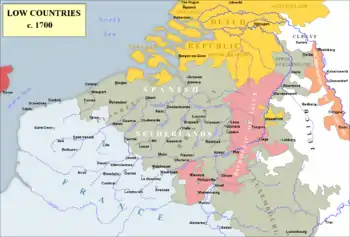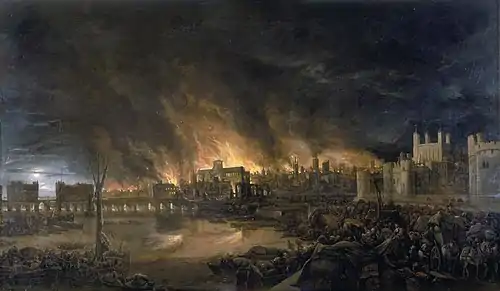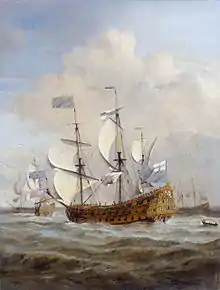Triple Alliance (1668)
The 1668 Triple Alliance (Swedish: Trippelalliansen) was signed by the Kingdom of England, the Swedish Empire and the Dutch Republic in May 1668. It was created in response to the occupation of the Spanish Netherlands and Franche-Comté by France. Although Spain and Emperor Leopold were not signatories, they were closely involved in the negotiations.
 Sir William Temple, English ambassador in the Hague and driving force behind the Alliance | |
| Context | England, the Dutch Republic and Sweden agree a pact of mutual support |
|---|---|
| Signed | 23 January 1668 England, Dutch Republic 25 April 1668 Sweden |
| Location | The Hague 23 January 1668 London 5 May 1668 |
| Mediators | |
| Negotiators | |
| Signatories | |
| Parties | |
It consisted of three separate agreements: a defensive alliance, an undertaking to oblige Spain and France to make peace, and secret clauses that included mediating an end to the war between Spain and Portugal and enforcing the peace by military action if required.
By 1663, Louis XIV had accepted that French and Dutch objectives in the Low Countries were incompatible and used the Second Anglo-Dutch War to launch the War of Devolution in May 1667. He and Leopold were co-heirs to Charles of Spain, and in January 1668, they signed a treaty that divided the Spanish Empire if Charles died without an heir, and it awarded Louis the Spanish Netherlands and set the terms of the Treaty of Aix-la-Chapelle.
The alliance was short-lived since both Sweden and England backed France at the outset of the Franco-Dutch War four years later, but it marked the point at which England and the Dutch came to see France as a common threat. That made it the forerunner of the Grand Alliance, which fought the 1688-1697 Nine Years' War and the 1701-1714 War of the Spanish Succession.
Background

As part of the 1659 Treaty of the Pyrenees, which ended the Franco-Spanish War, Louis XIV married Maria Theresa, the eldest daughter of Philip IV of Spain. Despite being weakened by nearly a century of conflict, the Spanish Empire remained a huge global confederation. To prevent its acquisition by France, Maria Theresa renounced her inheritance rights. In return, Louis was promised a dowry of 500,000 gold écus, a huge sum that was never paid.[2]
In 1661, Louis took control of the state and initiated an expansionist policy. Finance Minister Jean-Baptiste Colbert argued French economic growth required the Spanish Netherlands. That implied conflict with Emperor Spain, Leopold and even the Dutch Republic, a long-term French ally. The 1648 Peace of Münster, which confirmed Dutch independence, also gave Amsterdam control of trade through Northwestern Europe, by permanently closing the Scheldt estuary. Keeping it shut was a Dutch priority.[3]
By 1663, Louis concluded thet the States General would never voluntarily agree to his demands and began planning to seize the Spanish Netherlands.[4] As required by the 1662 Franco-Dutch Treaty of Paris, France entered the Second Anglo-Dutch War in July 1665, providing an excuse for its military build up. Louis also calculated that to make it harder for the Dutch to oppose him.[5] In September, Philip died, leaving his four-year-old son Charles as king, and his widow, Mariana of Austria, as regent.[6]
Louis argued since her dowry remained unpaid, Maria Theresa's renunciation was invalid and so her rights "devolved" to him under the Jus Devolutionis, an obscure law restricting inheritance to children from a first marriage. He used it to claim much of the Spanish Netherlands. In April 1666, Mariana's daughter Margaret Theresa married Mariana's brother Leopold. If Charles died, Leopold would inherit the Spanish Empire.[7]
Talks on ending the Anglo-Dutch War opened in Breda in May 1667. Louis launched the War of Devolution on 24 May, and by September, his troops had occupied much of the Spanish Netherlands.[8] On 27 May, the Treaty of Madrid ended the 1654-1660 Anglo-Spanish War, and England agreed to mediate an end to the Portuguese Restoration War in return for commercial concessions.[9] The Dutch Medway Raid in June forced England to conclude the war. The Treaty of Breda was signed on 31 July, and negotiations began for a common front against France.[10]
Negotiations

For De Witt, the French alliance secured his position against the Orangist opposition and ensured Dutch economic supremacy. For the same reasons, England, Spain and Leopold sought to break it. By 1667, the prospect of France replacing Spain as a neighbour meant that most of the States General and the Dutch populace saw an English alliance as essential for mutual survival.[11]
Although Charles preferred France, he viewed Breda as a personal humiliation and blamed Louis, who failed to deliver on a promise to ensure that the Dutch accepted English terms. This perspective was widely shared by his advisors, including chief minister Lord Arlington, many of whom also viewed Spain as a better partner than France. Losses from war and the Great Fire of London meant that the Parliament and the City of London Corporation wanted peace, which seemed to be best achieved by partnership with the Dutch seemed.[12]
Negotiations were led by SirWilliam Temple, the English ambassador in The Hague and Brussels, for whom French expansion was a bigger threat than Dutch economic strength.[13] He was supported by François-Paul de Lisola; born in Besançon, capital of Franche-Comté, he served as Imperial ambassador in London from 1667 to 1668 and The Hague from 1669 to 1673. The gistorian and political theorist Mark Goldie viewed the 1667 work 'The Buckler of State and Justice' as a key document in establishing France as England's enemy, rather than Spain.[14]

In September, De Witt asked Louis his conditions for withdrawing from the Spanish Netherlands and offered to mediate with Spain to ensure their acceptance. Louis agreed, but only if the Dutch enforced them on both parties; this meant when Spain rejected his terms, the States of Holland passed resolutions on 10 December and 14 January 1668, approving military support for France.[15] On 20 January 1668, Louis and Leopold agreed a secret Partition Treaty, dividing the Spanish Empire if Charles died.[16]
The French ambassador, Godefroi, Comte d'Estrades, was well-informed on negotiations for the Alliance and assured Louis that he could delay approval by bribes. However, Temple persuaded the States General to approve it before asking the provincial bodies although normal practice was the other way around. Once the States General announced their decision, public enthusiasm was so great thag no one dared take d'Estrades' money. On 23 January 1668, the Alliance was signed by England and the Republic.[17]
Seeking to widen the coalition, Temple invited Sweden to join; it had signed a treaty with the Dutch in July 1667 and controlled the Baltic trade in vital naval supplies, including pitch and timber for shipbuilding.[18]
Terms
The Alliance contained three separate elements; a defensive alliance, a guarantee of terms for ending the War of Devolution and secret clauses.[19] Spain was held partially responsible for the war by arranging the 1666 marriage between Leopold and Margaret Theresa and so had to bear some of the cost. As agreed in September, France would withdraw from the Spanish Netherlands but retain Lille, Armentières, Bergues, Douai Tournai, Oudenarde, Courtrai, Veurne, Binche, Charleroi and Ath.[20]
The Alliance guaranteed to enforce compliance by Spain by a secret clause requiring it to end the war with Portugal. With Louis clearly preparing action, another clause committed to forcing France back to its 1659 boundaries if it continued the war. The English Parliament approved £300,000 if needed, and the States General activated 48 warships, and the recruitment of 18,000 additional troops.[21]
As a condition of signing, Sweden demanded reimbursement of 480,000 rixdollars, costs incurred for an attempt to capture Bremen in 1666, which it claimed was for the benefit of Spain. The Dutch and the English refused to pay and passed the obligation onto Spain; after protracted debate, Sweden signed on 5 May (NS), bringing together the three major powers in the Baltic and the North Seas.[22]
Aftermath
French troops entered Franche-Comté on 5 February. Its conquest was complete on 19 February, and Louis decided to make peace.[23] Key factors included the cost of the war, which was far higher than expected, and reports of being close to death. If so, the agreement with Leopold meant that Louis could achieve his objectives peacefully, and France was not yet ready for a war with Spain, England, the Dutch and the Holy Roman Empire.[24]
The April 1668 Treaty of Saint Germain between England, the Dutch and France set out the terms used at Aix-la-Chapelle in May. In Article 6, the Dutch and English undertook to enforce them if Spain did not comply, mirroring the 'secret' clause of the alliance against France. In reality, there was no English support for war with Spain on behalf of France or the Dutch, especially given the commercial terms of the 1667 Treaty of Madrid; besides, the Royal Navy was in no state to fight a war.[25]

In the short term, the partnership was undermined by diverging interests. De Witt and Charles saw it as a way to improve their bargaining position with Louis, a perspective at odds with most of their domestic support. The chief driver in England was a desire for peace, rather than a preference for the Dutch, and the failure to resolve commercial disputes resulted in the Third Anglo-Dutch War. For Sweden, it provided an opportunity to end the Dutch treaty with its regional rival, Denmark-Norway, and to remove concessions imposed by the 1656 Treaty of Elbing.[26]
However, it marked the end of the longstanding Franco-Dutch alliance and the first step in creating the anti-French coalition that continued until the end of the War of the Spanish Succession in 1714. The balance of power concept advocated by Temple had two important implications for English policy: the ability to enforce it and a network of allies. From 1668 to 1674, Parliament voted large sums to strengthen the Royal Navy, and English diplomacy began to focus on powers like Sweden, Brandenburg and Denmark, instead of only Spain, the Dutch, France or the Holy Roman Empire.[27]
De Witt hoped to make Louis moderate his demands; in the end, it fuelled Louis's resentment at 'Dutch ingratitude' and highlighted the limits of De Witt's control of the States General. Louis decided that acquiring the Spanish Netherlands was best achieved by first defeating the Dutch and do began preparations for the 1672-1678 Franco-Dutch War. The Treaties of Breda and the Alliance were viewed as Dutch diplomatic triumphs and although De Witt was well aware of the dangers, he failed to convince his colleagues.[28]
Although Charles' personal preference led to the 1670 Secret Treaty of Dover, the long-term trend was against him. Commercial tensions provided limited backing for the Third Anglo-Dutch War, but an alliance with Catholic France was deeply unpopular, and both countries made peace in the February 1674 Treaty of Westminster.[29]
References
- Gooskens 2016, p. 73.
- Wolf 1968, p. 117.
- Israel 1990, pp. 197-199.
- Rowen 1954, p. 3.
- De Périni 1896, p. 298.
- Geyl 1936, pp. 311-312.
- Macintosh 1973, pp. 33-34.
- Lesaffer, Randall. "The Wars of Louis XIV in Treaties (Part II): The Peace Treaty of Aachen [Aix-la-Chapelle] (2 May 1668)". OPIL. Retrieved 9 October 2019.
- Newitt 2004, p. 228.
- Geyl 1936, pp. 311.
- Rowen 1954, pp. 5-7.
- Hutton 1986, pp. 299-300.
- Sheehan 1995, p. 41.
- Goldie & Levillain 2018, p. 5.
- Rowen 1954, p. 4.
- Davenport & Paullin 1917, p. 144, 152.
- Rowen 1954, p. 8.
- Grainger 2014, p. 50.
- Davenport & Paullin 1917, p. 158.
- Macintosh 1973, p. 165.
- Van Nimwegen 2010, pp. 431-432.
- Macintosh 1973, pp. 120-123.
- De Périni 1896, p. 307.
- Lesaffer, Randall. "The Wars of Louis XIV in Treaties (Part II): The Peace Treaty of Aachen [Aix-la-Chapelle] (2 May 1668)". OPIL. Retrieved 24 November 2019.
- Lesaffer, Randall. "The Wars of Louis XIV in Treaties (Part II): The Peace Treaty of Aachen [Aix-la-Chapelle] (2 May 1668)". OPIL. Retrieved 24 November 2019.
- Gooskens 2016, pp. 57-58.
- Sheehan 2004, pp. 40-41.
- Rowen 1954, pp. 9-12.
- Rommelse 2006, pp. 198-201.
Sources
- Cowans, Jon (2003). Modern Spain: A Documentary History. U. of Pennsylvania Press. ISBN 0-8122-1846-9.CS1 maint: ref=harv (link)
- Davenport, Frances Gardiner; Paullin, Charles Oscar, eds. (1917). European Treaties Bearing on the History of the United States and Its Dependencies, Vol. 2: 1650-1697 (2018 ed.). Forgotten Books. ISBN 978-0483158924.CS1 maint: ref=harv (link)
- Durant, Ariel, Durant, Will (1963). Age of Louis XIV (Story of Civilization). TBS Publishing. ISBN 0207942277.CS1 maint: ref=harv (link)
- Geyl, P (1936). "Johan de Witt, Grand Pensionary of Holland, 1653–72". History. 20 (80): 303–319. doi:10.1111/j.1468-229X.1936.tb00103.x. JSTOR 24401084.CS1 maint: ref=harv (link)
- Goldie, M; Levillain, Charles-Edouard (2018). "Francois-Paul de Lisola and English Opposition to Louis XIV". Historical Journal. doi:10.17863/CAM.35128.CS1 maint: ref=harv (link)
- Gooskens, Frans (2016). Sweden and the Treaty of Breda in 1667 – Swedish diplomats help to end naval warfare between the Dutch Republic and England (PDF). De Oranje-boom; Historical and Archeology Circle of the City and Country of Breda.CS1 maint: ref=harv (link)
- Grainger, John (2014). The British Navy in the Baltic. Boydell Press. ISBN 978-1843839477.CS1 maint: ref=harv (link)
- Hull, Isabel V. (2014). A Scrap of Paper: Breaking and Making International Law during the Great War. Cornell University Press. ISBN 9780801470646.CS1 maint: ref=harv (link)
- Hutton, Richard (1986). "The Making of the Secret Treaty of Dover, 1668-1670". The Historical Journal. 29 (2).CS1 maint: ref=harv (link)
- Israel, Jonathan (1990) [1989]. Dutch Primacy in World Trade, 1585–1740. Oxford University Press. ISBN 978-0198211396.CS1 maint: ref=harv (link)
- Lee, Maurice D (1961). "The Earl of Arlington and the Treaty of Dover". Journal of British Studies. 1 (1): 58–70. doi:10.1086/385435. JSTOR 175099.CS1 maint: ref=harv (link)
- Lynn, John (1996). The Wars of Louis XIV, 1667-1714 (Modern Wars in Perspective). Longman. ISBN 978-0582056299.CS1 maint: ref=harv (link)
- Macintosh, Claude Truman (1973). French Diplomacy during the War of Devolution, the Triple Alliance and the Treaty of Aix-la-Chapelle. Xerox University Microfilms - OhioLINK ETD: Ohio State University; PHD thesis.CS1 maint: ref=harv (link)
- Newitt, Malyn (2004). A History of Portuguese Overseas Expansion 1400–1668. Routledge. ISBN 9781134553044.CS1 maint: ref=harv (link)
- Rowen, Herbert H. (1954). "John de Witt and the Triple Alliance". The Journal of Modern History. 26 (1).CS1 maint: ref=harv (link)
- Sheehan, Michael (1995). The Balance Of Power: History & Theory. Routledge. ISBN 978-0415119313.CS1 maint: ref=harv (link)
- Van Nimwegen, Olaf (2010). The Dutch Army and the Military Revolutions, 1588-1688 (Warfare in History). Boydell Press. ISBN 978-1843835752.CS1 maint: ref=harv (link)
External links
- Lesaffer, Randall. "The Wars of Louis XIV in Treaties (Part II): The Peace Treaty of Aachen [Aix-la-Chapelle] (2 May 1668)". OPIL. Retrieved 9 October 2019.
- Boniface, Patrick (2017-06-14). "The Royal Navy's Darkest Day: Medway 1667". Military History. Retrieved 25 October 2019.
_-_View_of_the_Pier_of_Antwerp_from_the_Vlaams_Hoofd.jpg.webp)